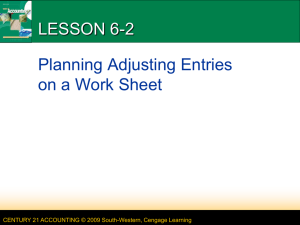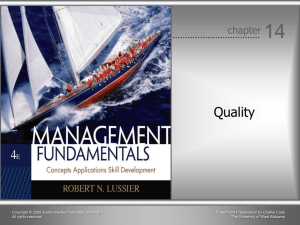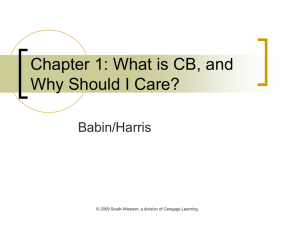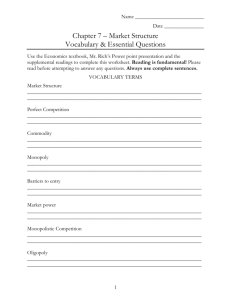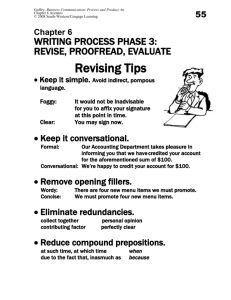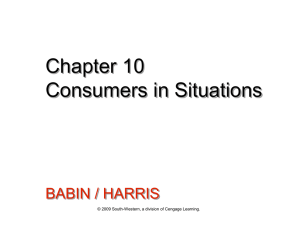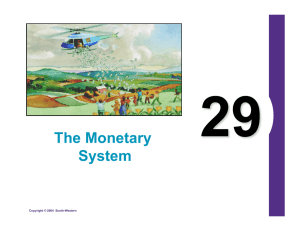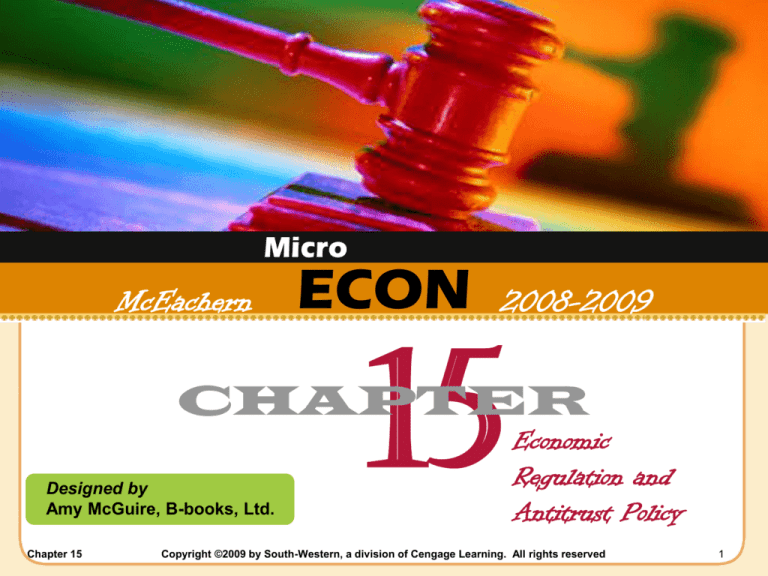
Micro
McEachern
ECON
2008-2009
15
CHAPTER
Designed by
Amy McGuire, B-books, Ltd.
Chapter 15
Economic
Regulation and
Antitrust Policy
Copyright ©2009 by South-Western, a division of Cengage Learning. All rights reserved
1
Types of Government Regulation
Market power
– Raise the price
• Without losing all
sales to rivals
– Firms
• Downward-sloping
demand curve
LO1
Chapter 15
Copyright ©2009 by South-Western, a division of Cengage Learning. All rights reserved
2
Types of Government Regulation
Government regulations
– Social regulations
• Improve health and safety
– Economic regulations
• Control: price, output, entry of new
firms, quality of service
– Desirable monopolies
• Control natural monopolies
– Antitrust policy
LO1 • Outlaws monopolies and cartels
Chapter 15
Copyright ©2009 by South-Western, a division of Cengage Learning. All rights reserved
3
Regulating a Natural Monopoly
Natural monopoly
– Downward-sloping LRAC curve
Unregulated profit maximization
– MR=MC
– Economic profit
– Consumer surplus
– P>MC, higher social welfare if
output expanded
LO2
Chapter 15
Copyright ©2009 by South-Western, a division of Cengage Learning. All rights reserved
4
Regulating a Natural Monopoly
Government
– Increase social welfare
– Lower P, expand Q
Public utilities
– Government-owned
monopoly
– Government regulated
monopoly
LO2
Chapter 15
Copyright ©2009 by South-Western, a division of Cengage Learning. All rights reserved
5
Regulating a Natural Monopoly
Setting P=MC
– Where D intersects MC
– Higher consumer surplus
– Monopolist: economic loss
– In long-run: monopolist
exits the market
– Needs subsidizing
LO2
Chapter 15
Copyright ©2009 by South-Western, a division of Cengage Learning. All rights reserved
6
Regulating a Natural Monopoly
Subsidizing the natural monopolist
– Government covers the loss
– Firm: earn normal profit
– Drawback: government must raise
taxes, forgo public spending
Setting P=average cost
– ‘Fair return’: normal profit
• Stay in business without a subsidy
2 – Higher social welfare (than unregulated)
LO
Chapter 15
Copyright ©2009 by South-Western, a division of Cengage Learning. All rights reserved
7
Regulating a Natural Monopoly
Setting P=MC or P=average cost
– Reduce P
– Increase output
– Erase economic profit
– Increase consumer surplus
– Increase social welfare
LO2
Chapter 15
Copyright ©2009 by South-Western, a division of Cengage Learning. All rights reserved
8
Regulating a Natural Monopoly
The regulatory dilemma
– If p=MC
• Socially optimal allocation of resources
– Marginal benefit=MC
• Monopolists: loss
• Requires government subsidy
– If p=average cost
• Monopolist: normal profit
LO2 • No socially optimal allocation
Chapter 15
Copyright ©2009 by South-Western, a division of Cengage Learning. All rights reserved
9
LO2 Exhibit 1
Regulating a Natural Monopoly
a
Dollars
per trip
Natural monopoly maximizes profit: MR=MC,
q=50, p=$4. Inefficient: p>MC.
Demand
c
$4.00
Efficient output rate: set p=$0.50, then
q=105 efficient outcome. But the firm:
economic loss; requires subsidy.
b
Profit
2.50
h
1.50
1.25
0.50
0
f
Loss
g
e
MR
LRAC
Alternative: set p=$1.50;
then q=90, the firm breaks
even (p=average cost);
earns normal profit.
Long-run MC
50
90 105 Trips per month (millions)
Social welfare could still be increased by expanding output as long as the
price >MC; but that would result in an economic loss, requiring a subsidy.
Chapter 15
Copyright ©2009 by South-Western, a division of Cengage Learning. All rights reserved
10
LO3
Alternative Theories:
Economic Regulation
Economic regulation
Public interest, promotes social welfare
Special interest of producers
‘Capture theory of regulation’
Producer groups
Expect to gain
Persuade public officials to impose restrictions
Consumers have no special interest
Reduce competition
Increase prices
Chapter 15
Copyright ©2009 by South-Western, a division of Cengage Learning. All rights reserved
11
Case Study
LO3 Airline Regulation and Deregulation
Chapter 15
1938 Civil Aeronautics Board
Regulated interstate airlines
40 years: No new interstate airline
Fixed prices among the 10 major airlines
Blocked new entry
Labor unions
Higher wages
Pilots worked
2 weeks/month
High price
Copyright ©2009 by South-Western, a division of Cengage Learning. All rights reserved
12
Case Study
LO3 Airline Regulation and Deregulation
Chapter 15
1978 Deregulation
Price competition
New entry
Price: one quarter below regulated price
More efficient airlines
FAA regulates quality
and safety
Accident rates
declines by 10-45%
More people fly
(passenger miles
tripled)
Copyright ©2009 by South-Western, a division of Cengage Learning. All rights reserved
13
Case Study
LO3 Airline Regulation and Deregulation
Chapter 15
Fierce competition
Mergers
Disappeared
Bankrupt
Lower wages
Lower fares
More flights
Saving lives
Copyright ©2009 by South-Western, a division of Cengage Learning. All rights reserved
14
Antitrust Law and Enforcement
Antitrust policy
– Reduce anticompetitive behavior
– Promote competition
Origins of antitrust policy
– Developments
• Technology: economies of scale
• Railroad: reduced transport costs
• Bigger firms, wider markets
LO4
Chapter 15
Copyright ©2009 by South-Western, a division of Cengage Learning. All rights reserved
15
Origins of Antitrust Policy
1873-1883 sharp economic decline
– Competing firms formed a trust
• Sugar, tobacco, oil industries
• Widespread criticism
Sherman Antitrust Act of 1890
– Trusts, restraint of trade, monopolization
Clayton Act of 1914
– Price discrimination, tying contracts,
exclusive dealing
4
LO
Chapter 15
Copyright ©2009 by South-Western, a division of Cengage Learning. All rights reserved
16
Origins of Antitrust Policy
Federal Trade Commission Act of 1914
– Federal Trade Commission
– Enforce antitrust laws
Cellar-Kefauver Anti-Merger Act
– Horizontal mergers
– Vertical mergers
LO4
Chapter 15
Copyright ©2009 by South-Western, a division of Cengage Learning. All rights reserved
17
Antitrust Enforcement
Antitrust division of the U.S.
Justice Department
FTC
Consent decree
Court trial
Judge decides
LO4
Chapter 15
Copyright ©2009 by South-Western, a division of Cengage Learning. All rights reserved
18
Per Se Illegality and
Rule of Reason
Per se illegal
– Illegal regardless of the economic
rationale or consequences
– Firm’s behavior
Rule of reason
– Reason and its effect on competition
– Firm’s behavior
– Market structure
LO4
Chapter 15
Copyright ©2009 by South-Western, a division of Cengage Learning. All rights reserved
19
Mergers and Public Policy
LO5
Chapter 15
Antitrust division and FTC
– Approve/deny mergers and acquisitions
– Herfindahl-Hirschman Index (HHI)
• Sales concentration
• Horizontal mergers
– Firms in the same market
• Nonhorizontal mergers
– Challenged mergers if
• Post-merger HHI>1800
• Merger increases HHI by >100 points
Copyright ©2009 by South-Western, a division of Cengage Learning. All rights reserved
20
LO5 Exhibit 2
Herfindahl-Hirschman Index (HHI) Based on
Market Share in Three Industries
Each of the three industries has 44 firms. The HHI is found by squaring each firm’s market
share then summing the squares. Only the market share of the top four firms differ across
industries; the remaining 40 firms have 1% market share each.
The HHI for Industry III is nearly triple that for each of the other two industries.
Chapter 15
Copyright ©2009 by South-Western, a division of Cengage Learning. All rights reserved
21
LO5 Exhibit 3
U.S. Merger Waves in the Past Century
Chapter 15
Copyright ©2009 by South-Western, a division of Cengage Learning. All rights reserved
22
Merger Waves
First wave
– Technological progress in transportation,
communication, and manufacturing
Second wave
– Stock market boom of 1920s
Third wave
– After WWII
Fourth wave
– One-third: hostile takeovers
LO5
Chapter 15
Copyright ©2009 by South-Western, a division of Cengage Learning. All rights reserved
23
Competitive Trends in
the US Economy
1. Pure monopoly
– One firm controls the market
– Block entry
2. Dominant firm
– One firm: more than half market share
– No close rival
LO6
Chapter 15
Copyright ©2009 by South-Western, a division of Cengage Learning. All rights reserved
24
Competitive Trends in
the U.S. Economy
3. Tight oligopoly
– Top 4 firms: more than 60% of market
output
– Evidence of cooperation
4. Effective competition
– Low concentration
– Low barriers to entry
– Little or no collusion
LO6
Chapter 15
Copyright ©2009 by South-Western, a division of Cengage Learning. All rights reserved
25
LO6 Exhibit 4
Competitive Trends in the U.S. Economy: 1939 to 2000
Chapter 15
Copyright ©2009 by South-Western, a division of Cengage Learning. All rights reserved
26
Competitive Trends in
the U.S. Economy
Growth in competition (1958-2000)
– Competition from imports
• One-sixth
– Deregulation
• One-fifth
– Antitrust policy
• Two-fifths
LO6
Chapter 15
Copyright ©2009 by South-Western, a division of Cengage Learning. All rights reserved
27
Case Study
LO6 Microsoft on Trial
Chapter 15
Charges
Protect Windows monopoly (90%)
Extend monopoly into Internet Explorer
Internet Explorer’s integration into
Windows 98
Microsoft: to make life easier for
customers
Government: boost IE’s market share
Predatory practices
Anticompetitive behavior
Copyright ©2009 by South-Western, a division of Cengage Learning. All rights reserved
28
Recent Competitive
Trends
Increased competition in U.S.
Growing world trade
– Three major automakers
• 80% of U.S. market in 1970; only 54% by 2006
Deregulation
– International phone service
• $0.88 a minute in 1997; under $0.10 by 2007
Technological change
– Three major TV networks
• 90% in 1980; under 40% by 2007
LO6
Chapter 15
Copyright ©2009 by South-Western, a division of Cengage Learning. All rights reserved
29
Problems with
Antitrust Policy
Competition may
not require that
many firms
Abuse of antitrust
Growth of
international
markets
LO6
Chapter 15
Copyright ©2009 by South-Western, a division of Cengage Learning. All rights reserved
30

